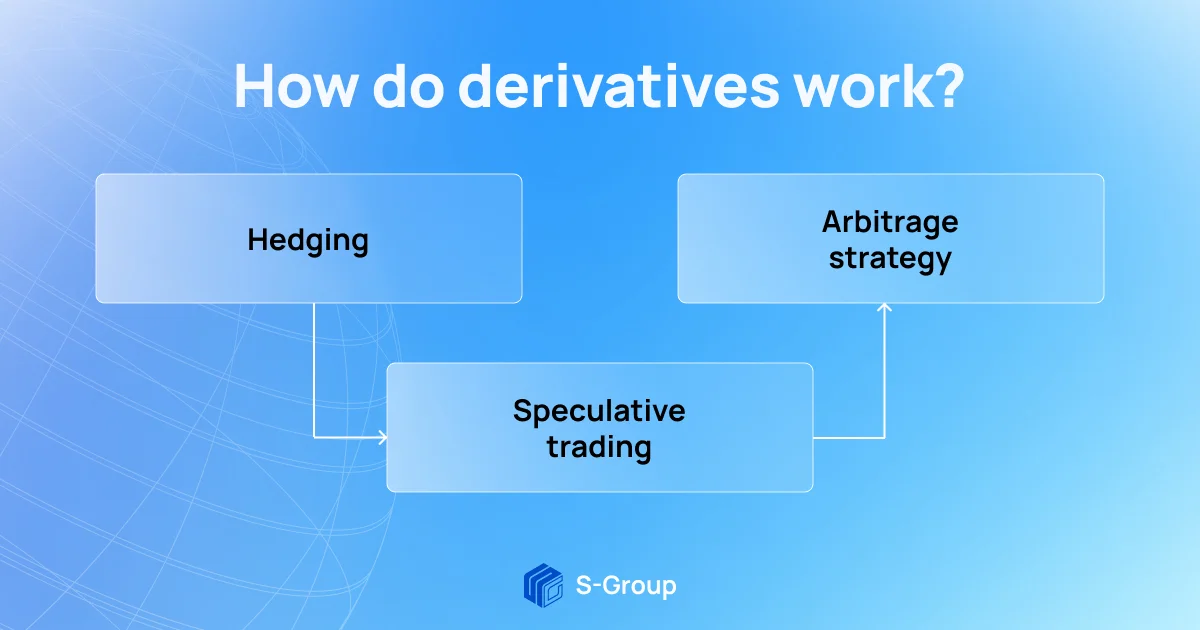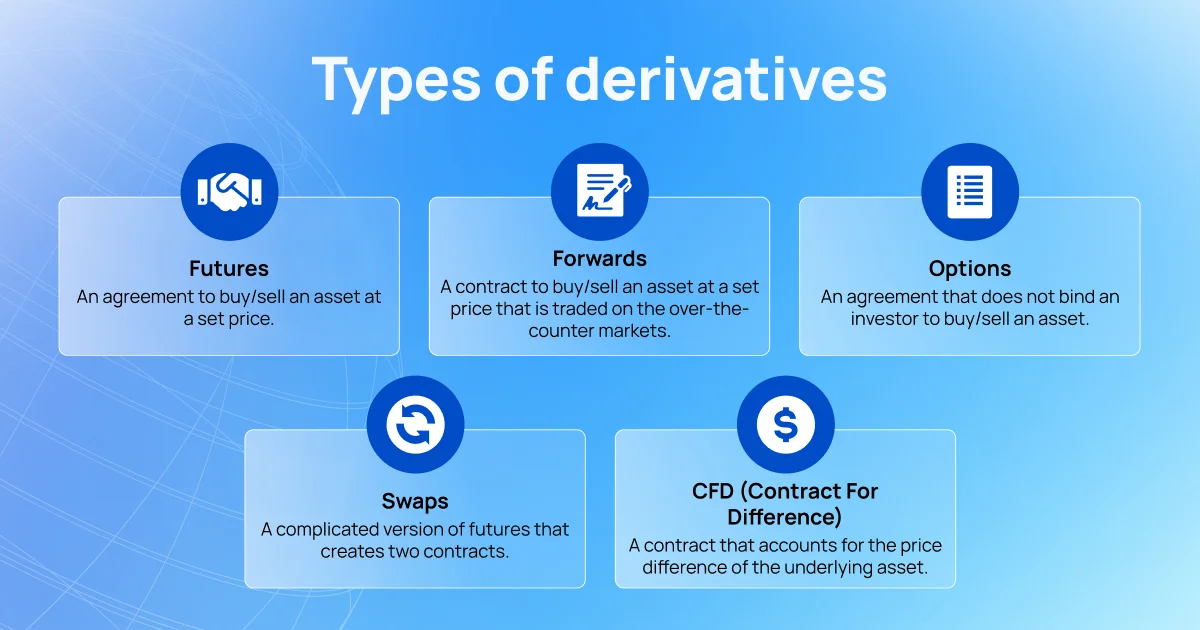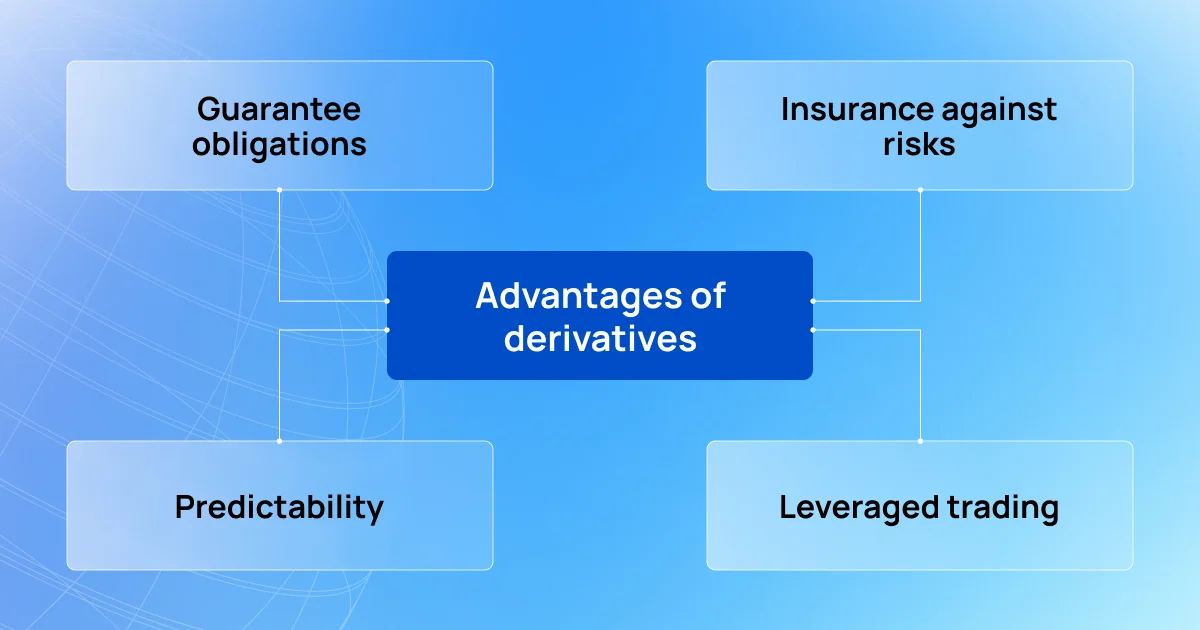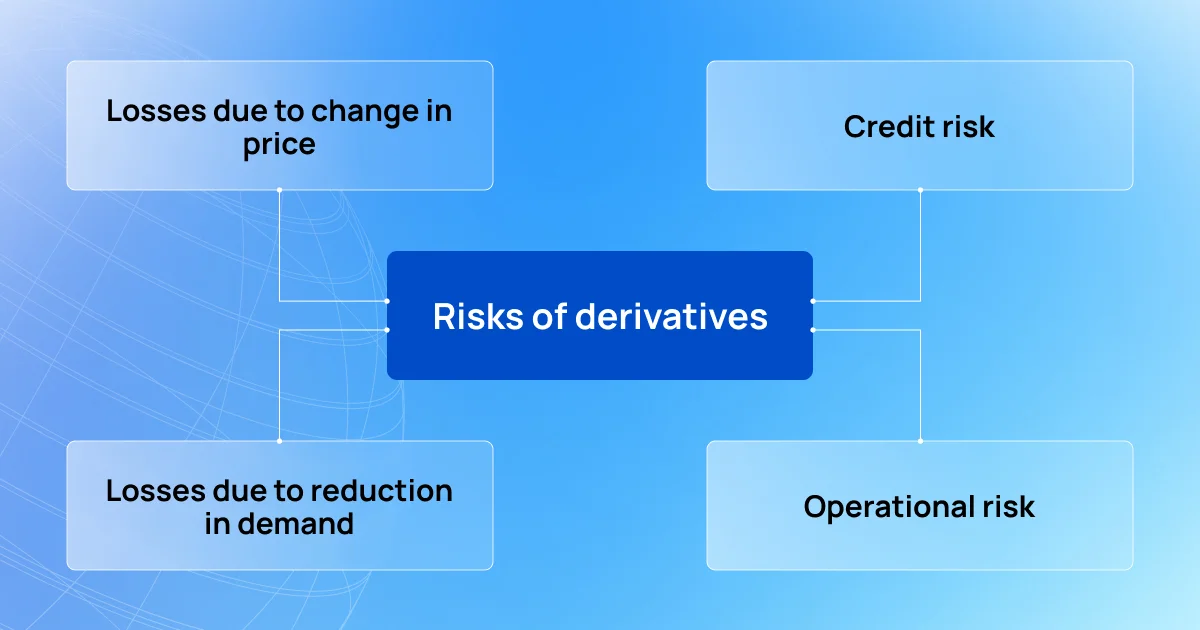Derivatives: definition and types

You can make money in the financial markets with two types of financial instruments: derivatives (stocks, currencies, bonds, equity indices) and derivatives.
This article will explain what derivatives are, how they work, and also what types of derivatives exist.
What are derivatives?
A derivative is a financial contract whose value is based on an underlying asset, e.g., equities, cryptocurrencies, bonds, etc. When two market participants enter into such a contract, they commit themselves to sell/buy an agreed amount of assets at an agreed price at an agreed time.
Let us look at an example. There is an investor who wants to sell shares in Apple because he expects the value of the assets to rise to $200. In such a case, the investor enters into an agreement with a buyer to sell 50 shares at $200. At the end of the week, the buyer is obliged to buy the agreed number of shares at the agreed price, regardless of what happens to the asset price. The buyer will still buy the asset at $200 even if the price falls to $150 or rises to $250.
Technically, derivatives are similar to securities, the only difference being that the seller and the buyer do not have to own the asset, and one of the parties can sell the contract at any time.
How do derivatives work?
Derivatives are created and issued by financial market participants, e.g., companies or traders, using an exchange as a derivatives platform. Generally, derivatives are used for the following purposes.

1. Hedging. This involves managing risk and eliminating exposure to future price movements. That is, an investor can open trades in one market to offset risks in another market.
2. Speculative trading. On the derivatives market, it is not necessary to pay the whole amount at once. That is, an investor may pay only a fraction of the price of the asset. Normally, they will deposit a security of 10% to 15% of the value. Due to this feature, derivatives can be resold and traded on short positions.
3. Arbitrage strategy. It is used by experienced investors who, based on knowledge and technical forecasts of the market, buy an asset in one market and sell it in another. In this way, they earn on the difference in price of derivatives on different markets.
Types of derivatives
The following types of derivatives are available in the financial markets.

- Futures
An agreement to buy/sell an asset at a set price. Futures can be compared to a pre-order, where the buyer leaves a deposit and agrees to collect the product after a certain time. For example, a pharmaceutical company has agreed to buy components for its drug three months in advance. Such a contract fixes the price and allows the business to avoid costs. If prices rise later on, the company will save substantially.
- Forwards
The same as futures, except they are traded on the over-the-counter market, which means they are not standardized and are not subject to the rules of the exchange. This means that there is a significant risk of not meeting the agreements.
- Options
A contract that does not oblige the investor to buy/sell an asset. To use an analogy, options are like asking you to hold an item for you in a shop. That is, going back to the financial markets, if the buyer does not guess the trend, he can walk away from the deal. The seller will not be left at a loss either, because in this case he will get compensation from the security deposit.
- Swaps
It is a more complicated variant of the futures. Two contracts are created in a swap: one showing the buy/sell conditions at the time of the transaction, the other showing the buy/sell conditions in the future. Creating a swap is similar to buying a commodity from a supplier and entering into a deal for future deliveries.
- CFD (Contract For Difference)
A contract that accounts for the price difference of an underlying asset. If an asset becomes cheaper, the buyer pays the difference; if it becomes more expensive, the seller pays the difference. It is similar to the seller's offer to pay the price difference if the buyer finds the product cheaper.
Advantages and Risks of Derivatives
Let's start with the advantages.

1. Insurance against risks. Entering into a contract protects the investor from sharp changes in the price of the asset.
2. Guarantee obligations. They protect the seller from losses if the buyer rejects the transaction.
3. Predictability. Due to their dependence on the underlying asset, the value of derivatives can be predicted, and price movements can be successfully predicted.
4. The possibility of trading with leverage. Investors have the opportunity to trade on the derivatives market with leverage. Leverage is used when an investor wants to enter into a transaction in an amount that exceeds the amount invested.
A little about the risks.

1. Losses due to changes in price. If the value of the underlying asset changes, one of the buyer/seller parties to the transaction suffers a loss.
2. Credit risk. If a transaction is leveraged and the buyer cancels it, it will be loss-making for the seller.
3. Losses due to decrease in demand. If the demand for the underlying asset of the derivative falls, its liquidity will decrease.
4. Operational risk. Time zone differences (settlement time), delays and failures in technical systems, and human error can all reduce the profitability of a transaction or even cause losses for either party.
Key findings
Derivatives are important financial instruments that help investors reduce the risk of losses from price spikes due to various economic factors, such as inflation or crisis. Moreover, they provide the opportunity for speculative trading and earnings.
But as with other financial instruments, an investor needs to have a sound knowledge of the market as well as trading experience in order for the prevailing number of trades to be successful.
Share
Interesting
Would you like to receive a digest of articles?
One email with the best articles of the week.
Sign up so you don't miss anything.